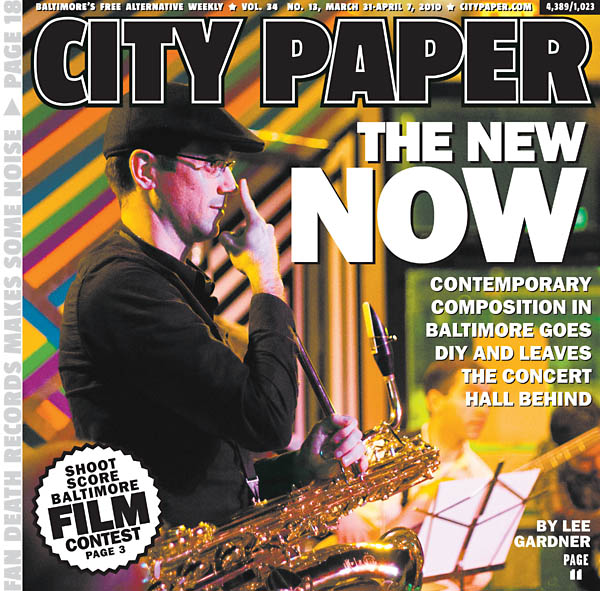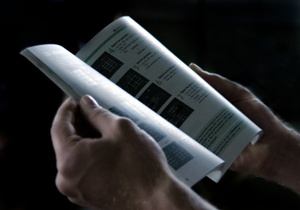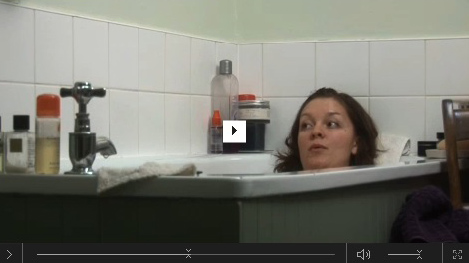Contemporary composition in Charm City. This is how we do it now.

No genre is the new genre
Contemporary composition in Charm City. This is how we do it now.

The whole “classical music to sell cars” trope is not news, but somehow the fact that a high-gloss coat of candy apple red backed by a drawing room-ready piece of piano noodling is still an effective way to move product fascinates me.* We should not ignore this pop culture fantasy, people! But, wait. Are we supposed to get off on the technical details? Oooohh, b flat major. Sounds positively scientific!
*More than that Lost episode did, at least.
 Maybe it’s best to listen first and ask questions later when it comes to appreciating music? That’s what a recent study published in the Psychology of Music journal seems to suggest. In “When program notes don’t help: Music descriptions and enjoyment,” Elizabeth Hellmuth Margulis (University of Arkansas) explores the reactions of non-musicians to samples of Beethoven string quartets. Those participants who listened without first wading through program notes found the experience more enjoyable. Margulis suggests that perhaps “when people without extensive formal training listen to music in terms of verbal descriptions, they may work so hard at connecting the notes into label-able phenomena that they lose the ability … to hear the subtle interconnections among the sounds. These interconnections may be fundamental to music enjoyment.” So much for “if you teach them, they will come.”
Maybe it’s best to listen first and ask questions later when it comes to appreciating music? That’s what a recent study published in the Psychology of Music journal seems to suggest. In “When program notes don’t help: Music descriptions and enjoyment,” Elizabeth Hellmuth Margulis (University of Arkansas) explores the reactions of non-musicians to samples of Beethoven string quartets. Those participants who listened without first wading through program notes found the experience more enjoyable. Margulis suggests that perhaps “when people without extensive formal training listen to music in terms of verbal descriptions, they may work so hard at connecting the notes into label-able phenomena that they lose the ability … to hear the subtle interconnections among the sounds. These interconnections may be fundamental to music enjoyment.” So much for “if you teach them, they will come.”
The study came across my desk via the new-to-me but very enlightening Miller-McCune website, and you can read more about Margulis’s work there (as well as a great piece on David Cope’s AI “composer”). Unless I’m actively researching a piece of music, I usually ignore the program or liner notes that accompany the auditory experience, at least at first. Like a child, I don’t want to be told things. A new piece of music is an exciting thing, and I want to run off and explore the sound world being offered. Let me get inside and wander around a bit before making me sit and read an essay rooted in someone else’s interpretation. Margulis is very cautious not to dismiss program notes as completely without merit, but reporter Tom Jacobs notes this tasty line from the report attributed to composer and musical theorist Leonard Meyer: “Listening to music intelligently is more like knowing how to ride a bicycle than knowing why a bicycle is ridable.”
(If the intro music to this post was undeniably Pink Floyd, then the exit track is provided courtesy of Queen.)
Well, it certainly wasn’t Grocery Store Musical…
…but the singers from the Washington National Opera’s Young Artist Program had a little of their own fun in the produce section last week. True to the “we are all members of the media” times, it appears that there may have been as many cameras as people on hand to observe the action.
I’ve been seeing an unusual amount of cool music-meets-science news of late, but this video presentation of Marcus Coates’ installation Dawn Chorus made the biggest splash in my birdbath by far. Seriously, the sounds alone left my mouth hanging open, but then check out the movements and the breath rate that’s visible in the clips of each subject. On fast forward, it’s as if these humans actually turn into super-sized birds.
(Click on the image to go to the full off-site video)

How did these people manage such amazing mimicry? Well, this being the 21st century and all, thankfully there’s YouTube video to sate demands for more info. And, small world, the demonstration subject is none other than our favorite birdsong man, David Rothenberg.
More about the work:
During rigorous fieldwork 14 microphones were placed around woodland to record birds during one morning of birdsong in Northumberland. From this multi-track recording each song was slowed down up to 16 times, then human participants were filmed mimicking this slowed down song. Finally the resulting video footage was then speeded up, returning the bird mimicry into its ‘real’ register. The films are presented on screens in the gallery relative to the position of the birds when they were recorded. (Full text here)
Since I seem to be in a poetic mood this week, here’s another delicate thing of beauty I stumbled across once again while wandering around on the internet.
This bit of stop-motion somnambulance has had plenty of play in the past year, but the artists are now selling off the pieces of this dream, image by image. Talk about memories that disperse through the intertubes and embed themselves in other people’s lives.
Her Morning Elegance music video was made of exactly 2096 still photographs, shot and sequenced to create the sense of movement using stop motion technique. After going from stills to motion, the artists decided to break the motion back to its still form and exhibit the 2096 individual photographs in gallery exhibitions worldwide. Each still photograph will be printed once as a single edition print and sold through this website. Once a photograph is sold, the corresponding second in the video will no longer be available. And with the very last frame sold, the video will have been broken apart, back to its original 2096 pieces, spread worldwide and hung in 2096 houses, bedrooms, living rooms and galleries.
More about the project can be found here.
[via watching this and getting here and falling into this]
Confidential to the composer who needed a little encouragement: A finished trailer for an unmade movie about a real artist’s imaginary struggles.
Whose unmade biopic would you want to see on the big screen?

We might be remembered forever. All our Twitter updates, our email, our Vimeo movies, our Xbox Live profiles, our wormy FourSquare maps. They won’t be important. Not to most people, anyway. But they’ll be there if the sysadmins take care of us, if the corporations and machines to whom we’ve entrusted our records do not fail or are not destroyed.
We won’t matter to most. But our memories will be cataloged, indexed, made available along with our stories, our names…
If you didn’t catch any of Gizmodo’s Memory [Forever] series last week, it may be worth your peek now. I caught the above quote thanks to a boingboing mention and haven’t been able to shake the concept since. How fragile most digital information seems to me. The intellectual output of an undergraduate education disappears in an electrical surge, volumes of letters vanish when an email account dies, albums of pictures evaporate when a registered pool goes unminded. In some ways, perhaps, our memories must lie in our minds more than ever now that we have 1000 vacation photos on a hard drive instead of 10 in a well worn coffee table album. Floods and fires, real and their digital equivalents, are ever present reminders of all we still can’t carry with us no matter how vast yet portable our storage devices get.
You have more of your memories stored online than all of your ancestors ever left behind. The future of memory is already here…I didn’t go to your party, but I saw 156 pictures of it on Facebook…
Still, the romantic in me wants to believe this kind of mapping is gaining ground: That several generations down, some interested great grandchild might be able to Google (or whatever the kids are doing then) a name and some relevant facts, and pour through pieces of lives lived long before they were breathing. Images, writing, music, art–personalities reflected in more facets than a smudged Polaroid and a few Christmas cards could ever offer.
Either reality seems frighteningly possible. So many memories could be preserved in all their unforgiving fullness or most of it could disappear in the march forward, the only remnants of a life left behind consisting of a dead Blackberry and what was scribbled on the backs of paper in the physical world–shopping lists tucked into coat pockets and receipts from the ATM slipped between the pages of books that were never finished.

I don’t think I’ve mentioned this here before, but I am obsessed with This American Life. If Ira Glass called tomorrow to ask if I’d be the show’s unpaid intern, I would be on a bus before the line went dead.
But seriously, what I love about this show, and what I want to learn to do better in my own media production, is how well they bring stories about the most average of people to bold, colorful life. (Their TV series was also great, but somehow their approach comes across even more vividly in the audio-only format.) Even when a particular episode sounds like it won’t make an impression on me at all, it usually does anyway. Often it connects even more fiercely. For instance, I have listened to Sarah Vowell’s contribution to episode 81: Guns (aired 10/24/1997) about four times now. You can check out her section, “NRA vs NEA,” here. Just fast forward to the 4:08 mark if you want to get right to it. It runs about eleven minutes.
I was thinking again about the way TAL illuminates stories because I was at a concert last night and the program was hard and high. Kaija Saariaho, Jason Eckardt, Pierre Boulez. But part of what made this night work was that the performers were making some pretty fast connections with the crowd, saying just a few things about why they cared about these sounds and so, by extension, why we should. We were prepared for the music, but we also got this great glimpse into how they had prepared the music in the weeks and months prior to that moment and what made them tick as people. In particular, Katayoon Hodjati, a flute player who can’t clock much over 5 ft. tall, stood between two huge pieces of poster board that were propped up on music stands and told us how Brian Ferneyhough’s Casandra’s Dream Song had turned into a kind of nightmare for her. For a while, she could only bear to deal with the music a line at a time and carried pieces of the carved up score around with her. When she worried that she wouldn’t be able to read the music under the stage lights, she went to Kinkos and blew the pages up–they were huge–so she was sure not to miss the details.
Then she played, and for a little while at least, it felt like we were really sharing in the dream with her. It’s likely as close as I will ever come to perfecting a Ferneyhough piece, and it made for an extra thrilling ride. But I’ve been wondering since how Ira Glass would have illuminated this story of solo musician, new music, difficulty, and fear. What would he have asked, and what would he take away? I have some reading to do.
Okay, kids, let’s put our heads together. To save classical music, what viral video ploy would you use? (That is, of course, unless you think current classical music marketing is doing the job just fine the way it is, thank you very much.)
Yeah, I’m not being altogether serious, but a lot of viral videos do capitalize on some bit of musical, um, ingenuity. Two cases came across my desk this morning that seemed worth noting here in MTG, however. Instead of cats playing keyboards, hipsters playing with auto-tune, or ingratiating wordless Russian melodies getting jammed down our ears (accidentally!), these latest viral videos capitalize on freestyle piano improv and the classical music. Thought this could never be?
Yeah, me too. But just watch as a million stereotypes are piled on top of one another so that a string quartet can sell beer to 1,000 soccer fans…
On the night of the October 21st the Real Madrid played Champions League match against AC Milan. Heineken convinced several university professors, girlfriends, and several bosses to convince their students, boyfriends and employees to go to a concert on that night. All of them couldn’t say no and had to go to the classical concert.
But…
[via Mashable]
Also…
Your host, Merton, freestyling in real-time with random strangers on Chat Roulette. No piano lessons, Merton is self-taught. Not Ben Folds. Seriously.
[via Waxy]
UPDATE: From the comments (thanks, Acheron!) Keep ’em coming, folks.
an ArtsJournal blog
